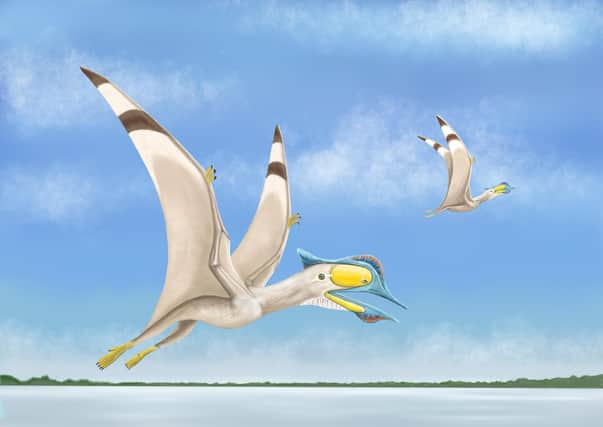University of Portsmouth scientists discover fossilised remains of fourth species of flying reptile


The discovery, which was made by University of Portsmouth palaeobiologists, comes hot on the heels of last week’s revelation that a third pterosaur had been uncovered in Morocco.
The new species belongs to a group of pterosaurs called tapejarids from the Cretaceous Period, which spanned between 145 million and 66 million years ago. Tapejarids were small to medium-sized pterosaurs with wingspans as wide as four metres, most of which had large, broad crests sweeping up from the front of the skull.
Advertisement
Hide AdAdvertisement
Hide AdLeading the team was professor David Martill from the University’s School of the Environment, Geography and Geosciences,
Professor Martill said: ‘The study of Moroccan material shows that we are still far from having found all the paleontological treasures of North Africa. Even fragmentary fossils, like the jaw piece of the new pterosaur, can give us important information about the biodiversity of the past.’
PhD student, Roy Smith, added: ‘I feel very privileged to be part of such an exciting discovery. Working in the Sahara was a life-changing experience and discovering a new species of pterosaur is the icing on the cake.’
The new pterosaur has been named Afrotapejara Zouhrii to honour the Moroccan palaeontologist, professor Samir Zouhri.
Advertisement
Hide AdAdvertisement
Hide AdPterosaurs ranged in size from as large as a fighter jet to as small as a model aeroplane.They are well known in Brazil and China with specimens also having been discovered in Europe but this is the first time the flying reptiles have been found in Africa.
The main difference from the three previously discovered creatures is that this species had no teeth.
The fossilised remains are now part of the collections of the Faculty of Sciences at Casablanca Hassan II University.
A MESSAGE FROM THE EDITOR
Thank you for reading this story on portsmouth.co.uk. While I have your attention, I also have an important request to make of you.
With the coronavirus lockdown having a major impact on many of our advertisers - and consequently the revenue we receive - we are more reliant than ever on you taking out a digital subscription.
Subscribe to portsmouth.co.uk and enjoy unlimited access to local news and information online and on our app. With a digital subscription, you can read more than 5 articles, see fewer ads, enjoy faster load times, and get access to exclusive newsletters and content. Visit our Subscription page now to sign up.
Our journalism costs money and we rely on advertising, print and digital revenues to help to support them. By supporting us, we are able to support you in providing trusted, fact-checked content for this website.
Comment Guidelines
National World encourages reader discussion on our stories. User feedback, insights and back-and-forth exchanges add a rich layer of context to reporting. Please review our Community Guidelines before commenting.